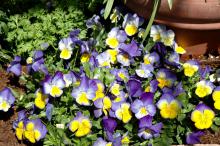Information Possibly Outdated
The information presented on this page was originally released on October 12, 2006. It may not be outdated, but please search our site for more current information. If you plan to quote or reference this information in a publication, please check with the Extension specialist or author before proceeding.
Ultima Morpho named Mississippi Medallion
By Norman Winter
MSU Horticulturist
Central Mississippi Research & Extension Center
The cooler weather of October means one thing -- it's pansy planting time in the South. I was on the coast the other day and one of the restaurants already had quite a display. There are so many great new selections that you may have a hard time making a decision. That's where I come in, and I want to suggest this fall's Mississippi Medallion Award-winning Ultima Morpho.
The Ultima series is not the largest on the market, but it certainly has some of the most beautiful varieties. The Morpho tops the list with its distinct bicolor design. The upper petals are medium blue with bright lemon-yellow lower petals, and rays or whiskers that radiate from the center. Ultima Morpho is named after the tropical Morpho butterfly, which also is blue and yellow.
Blooms measure about 2 1/2 inches across, and their color blend is superbly variable. Sometimes the yellow portion takes on darker orange hues. Mounded plants reach just 6 to 8 inches high and wide -- compact enough to set as accents, yet colorful enough for a mass display. In southern fall plantings, Ultima Morpho has proven to flower freely all season.
Ultima Morpho is the Mississippi Medallion Award winner, but also keep your eyes open for Blueberry Thrill. It is the same size as the Morpho and bears an abundance of 2 1/2-inch flowers with a beautiful purple background, primrose and yellow overlay, and a small purple blotch in the center.
If red and yellow are your favorites, then look for the Ultima Radiance Red. These pansies are the same size and give the same performance as the Morpho and Blueberry Thrill, yet they have rusty red outer petals that give way to orange and yellow with dark whiskers in the center.
No matter which you choose, the key to pansy success lies in bed preparation. Pansies do not perform well in tight, heavy soil. Amending the planting area is one of the best ways to have success over these conditions. Add organic matter such as fine pine bark (pieces less than 1/2 inch), leaf mold, compost, peat and sand.
If you haven't been happy with growing pansies previously, I would urge you to try buying baled peat. Incorporate a 3- to 4-inch layer of organic matter like peat in with the native soil to build up the bed and provide excellent drainage.
Be aggressive with your pansy planting, massing them in large quantities. Though certainly suitable for pocket planting at the front door, spot planting the pansy seldom yields the look you desire.
Pansies are available in various sizes ranging from jumbo six packs to those grown in a 4- or 6-inch container. Larger plants in bloom give you the most immediate impact, as well as a larger root system that aids in establishment. Be sure to mulch after planting. Though I use pine straw in a lot of beds, I am partial to pine bark around pansies.
Many gardeners do not realize that pansies are heavy feeders. Feed with a light application of a slow-release fertilizer monthly, or a dilute, water-soluble 20-20-20 every other week. Pay attention to soil moisture levels as cold fronts often drastically dry out the bed.
The weather is cooler and rains are finally in the forecast. Take advantage of the weather and get those beds prepared because it is pansy-planting time at last!



